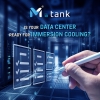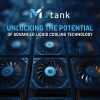


AI is driving rapid transformation across industries. However, deploying AI applications requires massive amounts of energy and generates substantial heat. A study predicts that by 2027, AI workloads could consume between 85 and 134 terawatt-hours annually, which is comparable to the total electricity usage of an entire country such as the Netherlands. In this context, immersion cooling has become a practical and efficient solution in terms of both performance and cost.
1. Thermal Performance and Hardware Stability
Liquid cooling absorbs heat much more efficiently than air. Immersion cooling fluids offer thermal conductivity that is 1,120 to 1,400 times greater than air. This allows AI hardware to maintain optimal operating temperatures, prevents thermal throttling, and supports faster and more reliable data processing. A study conducted in 2023 reported that immersion cooling can improve computing performance by up to 96 percent.
2. Operational Efficiency and Cost Optimization
- Fewer moving parts: traditional fans and large-scale air conditioning units are replaced by compact, sealed immersion tanks.
- Reduced maintenance: the enclosed system helps prevent dust accumulation, corrosion, and mechanical failures.
- AI-driven operations: AI technologies can manage system workloads and analyze data to enhance uptime and minimize operational disruptions.
3. Increased Density and Reduced Footprint
Immersion cooling systems support very high server densities. They can handle up to 250 kilowatts per rack, which is approximately five times higher than what is typically supported by air-cooled infrastructure. This allows data centers to host more servers without needing to expand their physical space or install additional cooling equipment.
4. Lower Energy Costs and Improved Sustainability
- Energy consumption for cooling can be reduced by 50 to 60 percent, leading to lower ongoing operational expenses.
- Water usage is significantly reduced, with some reports showing reductions of up to 90 percent.
- Power Usage Effectiveness (PUE) can be lowered to 1.03 to 1.04 or even less, which indicates exceptional energy efficiency.
5. Total Cost of Ownership (TCO) for a 10 MW Deployment
- CAPEX: initial investment is approximately 41 percent lower than with air cooling solutions.
- Annual OPEX: ongoing expenses can be reduced by approximately 39 percent, mainly due to energy and maintenance savings.
- Ten-year TCO: total cost of ownership can be reduced by up to 39 percent, equating to roughly 111 million USD for a 10 MW installation.
Ready to Explore Immersion Cooling?
If your organization is considering adopting immersion cooling and requires end-to-end guidance, including infrastructure evaluation, cost analysis, and pilot deployment, we encourage you to contact CSD Group for expert support.
CSD TECHNOLOGY GROUP JSC
Your trusted partner in deploying on-premise cloud solutions integrated with green cooling
technologies.
Our team of experts is always ready to provide consultation and design tailored solutions aimed
at building powerful, energy-efficient, and environmentally friendly digital infrastructure for
each business.
Address: 462 Cao Thang St, Hoa Hung Ward, Ho Chi Minh City, Vietnam
Hotline: Mr Quan - 0907536513 (Zalo)
Email: sales@csdgroup.com.vn


